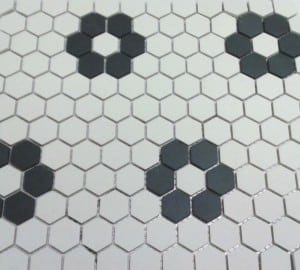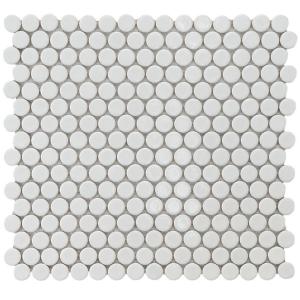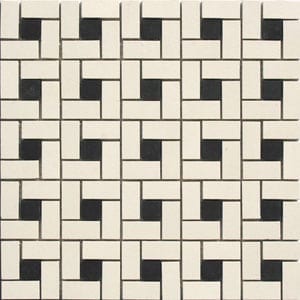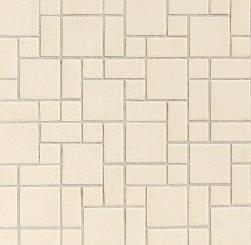
Tile is possibly the biggest design element of any bathroom. And if you are working on a vintage bath, it’s important to use historic floor tile patterns that fit your home.
If your bathroom was “remudeled” in the past it can be hard to find a floor tile that will fit your home’s age and style. Most of these floor tile patterns were popular from the early 1900s until WWII and will fit nicely with any old house bathroom.
If your house is older than 1900, it’s very possible the bathroom was an addition since indoor plumbing wasn’t considered a necessity until after that time. Before then, only the wealthiest homes had a bathroom. The rest of the world made due with a chamber pot and a commode which was a type of a nightstand for when nature called in the middle of the night. Because of that most vintage bath designs, even on much older houses, will fit into the 1900-1930s style.
The small format of these tiles served an important purpose. The small size of most early 20th century bathrooms makes them poor candidates for large format tiles. These little tiles allowed for unique designs and the small tile made the cramped spaces feel much bigger than they actually were.
Hexagon

Image Credit: luxetile.com
Hexagon tiles (typically white) were a hugely popular choice for floor tile. The design of these can be as simple as all white or could contain a complex pattern of different colors and designs. Their small 1″ size allowed for some very creative mosaic patterns to be incorporated by a skilled tile setter.
Often times, the field of white hex tiles would be left bare with merely a mosaic border pattern in black or some other accent color to give a pop to the otherwise antiseptically white bathrooms of the day.

Image Credit: HomeDepot.com
Penny Round
Penny round tiles, while not as popular as their hexagon cousins, were another popular mosaic tile option. These tiles typically came in 3/4″ and 1″ size and because of their small size they create a very unique look, especially from a distance.
Their round shape creates a larger portion of grout than with most other tile options so grout color becomes very important with this style.
Square

Image Credit: Restorationtile.com
You don’t have to have odd shapes like hexagons or penny rounds to be in style with historic floor tile. Square mosaic tile fits the bill quite nicely. Little 1″ square tiles (3″ and larger tiles are a different style entirely) were another very popular choice for floor tile. Often, borders for the hex and penny round floors were done with 1″ square tiles in a multitude of colors.
Border designs like Greek keys, winding belts, family names, and any other imaginable designs were fairly common. While most popular in the borders, they were also readily used as field tile as well.
Basket Weave

Image Credit: merchantcircle.com
This style is not as difficult to install as it may look. These tiles come in 12″ x 12″ sheets, just like the hexagons and penny rounds. Usually black and white (which was the theme for the average home bathroom) this tile really gives the illusion of being weaved together. It’s a little more difficult to install since you have to be careful to follow the pattern precisely from sheet to sheet. Though this photo shows marble tile, it is available like all of these options in marble or ceramic.
Pinwheel

Image Credit: Mosaictilesupplies.com
Especially popular in the 1920s and 1930s, Pinwheel tile patterns are a simple and fun design. They were rarely any other color than the standard white with a black center, but on a rare occasion, you might find a dark blue tile in the center of the pattern.
This pattern works well in a large or small space and was also a popular option in kitchens of the day.
Block Random

Image Credit: Daltile.com
It may seem as the name suggests, but this tile does actually have a specific pattern. This tile was fairly popular in the late 1930s and thru the 1940s in a variety of colors. The 1940s gave rise to thousands of color combinations for this tile pattern as it became increasingly popular throughout that decade.
If you have a historic house and you stick with one of these 6 historic floor tile patterns, no one will know it is anything other than original. Colors and patterns changed significantly over these decades.
The early 1900s were more colorful to fit the sensibilities of the fading Victorian style. Other than the earth colored tiles found in Craftsman style homes, the late 1910s and 1920s were obsessively white tiled rooms because of the recent discovery of germs and the resulting sanitary craze. It was thought that white made it easier to spot germs. The 1930s was a mix of the sanitary white and the crazy bold colors found in Art Deco homes. In the 1940s the other color schemes faded and pastels like pink (not a girl’s color at the time), blue, yellow, and green rose in popularity along with creme colors.
If you have one of these infamous pink bathrooms you should visit SaveThePinkBathrooms.com before ripping things out for some interesting perspectives on your bathroom.
Don’t be intimidated by the big prices on these small tiles. Buying enough tile to finish a bath as tiny as most historic bathrooms won’t break the bank. That leaves you the ability to spend more per square foot and get some really nice tile that will last as long as you old house has.
Subscribe Now For Your FREE eBook!

Founder & Editor-in-Chief
I love old houses, working with my hands, and teaching others the excitment of doing it yourself! Everything is teachable if you only give it the chance.


I have marble penny round tile in my 1915 bungalow’s only bathroom. Looks to be set in concete and not grouted. So hard to keep clean. I’ve scrubbed with Ajax (for the bleach, the pumice, and the blue-ing agent). But how to seal it? Don’t want a chemical glaze. What do you think of wax, maybe even a lime wax as a whitening “cheat” perhaps?
Hi Scott,
I’m having Restoration tile pinwheel installed in my bathroom and wondered if you could help me with some info.
RT recommends sanded grout with no additives, to mimic the original mortar, but my excellent tiler believes that sanded grout is unsuitable for such small grout joints and wants to use unsanded. I called the company to speak to someone, but the owner, whose recommendation that was, has passed away.
Could you tell me whether you agree with the sanded grout, and, if so, give me some reasons why it will work, to help my tiler come around?
Thanks!
Cara
For grout joints 1/8″ or smaller unsanded is recommended but you can use sanded grout if you want. Honestly in such small joints it would be hard to tell what kind of rout you used. If you are doing larger joints than 1/8″ the definitely use sanded, but smaller than 1/8″ I would say is personal preference.
Thank you!
Hi Scott,
The tiles are in and they look fantastic. I love the fact that the edges are flat and not rounded, and they feel great to walk on.
One problem: they are HORRIBLE to keep clean. In fact some of the tiles already seem to have ground in dirt that strong peroxide, soap, scrubbing, and whatever else I try does not remove the dirt.’
Do you have any suggestions for cleaning? Can they be sealed?
Thank you in advance.
Cara
I found the ONLY thing that works on the Restoration Tile is the “miracle sponge.” I get the tougher “sandwich” ones from spongeoutlet.com where they seem to have the best price.
Hi Scott, we just started the process of remodeling our bathroom in our 1938 Tudor. After removing a half wall that was added in the 80’s from the previous owner, we discovered under a layer of glow in the dark star floors (yes, we’ve been living with that) and linoleum, beautiful random block tile (white with random black pieces). I was over the moon until I started peeking in another area of the bathroom floor and realized that it didn’t continue. I think there had to be an addition added to the bathroom. I want to do everything to salvage these floors. Do you have any recommendations for finding or laying this type of tile? Our plan was to use mosaic hexagon tile until we discovered the original tile. I’d much prefer to keep the original.
Try checking with RestorationTile.com. They can make tile patterns to match almost anything you find.
Love the styles and choices in RestorationTile’s catalog. Can you comment on the durability of ceramic vs marble (in our case for a completely new job, not repair)? Is marble for some of these designs even an option today? If so, any suppliers you recommend?
Marble is an option but it is not as resilient as ceramic. Still a great choice that ages gracefully.
Hello, I need to replace an authentic pink marble 12″x12″ tile floor near knoxville,TN. The existing, original tile is 1 1/2″ to 2″thick. It was built in the early1900’s.Can you help me find this?
Hi Steve, my home was built in 1878, your suggestions for tile patterns are for after the 1900’s. Do you have recommendations for bathroom tile in the late 1800’s?
Try restorationtile.com. For 1880s it’s usually mosaics in darker earthy tones. Whites didn’t become popular until the 1910s and 1920s.
Question for Scott – we are restoring a bathroom in our victorian home and chose one inch porcelin hex tiles. The tiles were pricey and ordered from a company that specializes in historic tile, but they are only 3/16 of an inch thick. We are worried that the tile is too thin to hold a claw foot tub and be durable over the long run. The tile is non-returnable. What is your opinion – thanks!
Mary, I’m sure the tile will support your tub. Tile’s holding strength when set flat in a bed of mortar is pretty significant and doesn’t have much to do with thickness.
I have an white hexagon pattern with a black and white .75 inch square trim. The house was built in 1927 and I am trying to keep the fixtures original. A few of the pieces have detached and lost over the years. Where can I get replacements.
Do you have a picture of that floor?
I just found hex on tiles on my bathroom floors. How can I restore them? They are dirty, have some stains. What do I need to do?
Thanks,
Chris
It really depends on what dirt or residue is on them. Try a bunch of cleaners (don’t mix them together to avoid any bad reactions) and see which works best for your particular situation.
I found a long crack I the middle of the bathroom floor. Is there a way to repair?
Also, there is a spot, probably under the old tub, that there is only concrete, no tiles, any suggestion of what to do?
I’m wondering whether you know of any other sources besides Restoration Tile for square-edged mosaics. Even in a small room, $25/foot adds up very quickly.
Thanks for all the useful info!
I am in the process of remodeling an a bathroom that was added onto my house built in 1914. I really would like to keep with the style of the house but hexagonal tiles with white grout seems like a nightmare to keep clean. Do you have any suggestions about that?
Virginia, the hex tiles are no harder to keep clean if you use a medium gray grout. The contrast looks good and you won’t notice any dirt from traffic. I’d never recommend white grout on the floor.
Thank you for your response. You inspired me to go buy a medium grout colored paint for my white grout in my first bathroom. I have another question for you. What do you think about the marble hex tiles? Do you think it’s preferable to go with ceramic? I see the hex tiles come in different sizes also. Would you stick with the smaller ones? Is white the only color that is historically accurate? It’s interesting to me how the bathrooms are so stark white in contrast to the earth tones associated with the craftsman look. Well It looks like I had more than one question! I appreciate your help! Thanks again!
I’m wondering the same! Is a 2” equally historically significant to a 1” or just a compromise with the larger tiles of the 1950’s? I’m trying to bring some historic back to my 1920’s bungalow cottage. I’ve landed on Carrerra marble. Also considering a large tile surround.
My Craftsman bathroom is now gutted. I wanted to save the hexagonal floor tile, but it had damage from previous renovations/drains/radiators etc. The tile would not come up itself as it was laid on 3 ” of concrete. The solution was jack hammer and rubble removal. Now I have had in floor radiant heat installed and removed the radiator. I thought I would put a slate looking ceramic tile in, but after seeing this blog, I think I will go back to what was there! Thanks for the inspiration!
Thanks for your comment! So glad you’re keeping it in the original style. There are lots of beautiful old styles out there to choose from and the bathroom will fit perfectly with the house moving forward!
I have a question. Our 90-year-old house has a square cut hex mosaic bathroom floor that’s in perfect condition. However, two tiles (a black and a white) have been swapped which throws off the pattern and your eye immediately finds it. I had heard that this was done on purpose to show it was laid by hand and therefore shouldn’t be perfect. I suppose mosaics weren’t backed by mesh in 1925 (?) and this would require a skilled hand. Is this true?
Don’t know if that is true Jen but I like the story! In 1925 they were indeed set by hand without a mesh backing though.
I own an old Craftsman Bungalow built in 1924 in Cranston RI. I have no idea what the original tile was in the bathroom. Ripped out and replaced by lime green fake tile paneling long before I purchased the house. I did a remodel 25 years ago with a cheap tile.
I want to remodel again with period correct tile. I’m thinking subway tiles in an earth tone for the walls and shower/tub area.
Anyone have any links to post for companies willing to sell to homeowners?
The original floor was still in the BR. It was 3/4″ oak. And in very bad condition. Had to be replaced. I used porcelain tiles. Not a scratch on them after 25 years but they are going.
Not sure if I should use wood like Brazilian Cherry (Jatoba) or floor tiles.
I put the Jatoba in my kitchen and its very durable and impervious to water.
do you know if there is any place i can get vinyl tile, or sheet vinyl, that has the pattern of old hex tile? i want something for the floor of a bathroom in a craftsman type home and wonder if there is any way to get this look without having to use actual ceramic tile. thanks for any leads/suggestions.
There’s nothing I know of like this but that doesn’t mean it doesn’t exist. Though I wouldn’t imagine it would look remotely like actual tile.
hi scott,
i called linoleum city in LA and they do make a vinyl in the old hex pattern. he said it is mostly for movie sets etc and there is no guarantee, but it is a good material. he is going to send me samples.
here is the link:
http://www.linoleumcity.com/specialty.html
Just found your blog, and look forward to spending time perusing your site! My husband and I live in an old home (approx. 100 yrs. old). It is not an especially grand home-just a simple one story cottage in South Carolina. We are taking on a bathroom renovation, and I am driving myself crazy trying to choose the right floor tile! In addition to the options you listed on this post, are there any other patterns that could be appropriate? I am not necessarily interested in a Period restoration, but I do want a timeless look. I had settled on Carrara marble subway tiles laid in a herringbone pattern, but now I’m second guessing myself! My goal, when done, is for it to be something I won’t grow tired of that leaves guests wondering if its been there 2 weeks or 50 years! I would appreciate any opinions! Thanks!
Wanting the square tile pattern floor featured in Dec 9 2013 the colors are just like we want. How do we purchase this or have made up like in article. Please help us!
Debbie, that tile pattern is made by American Restoration Tile http://www.restorationtile.com. Their work is usually custom so it can be expensive, but the tile is incredible stuff that is a perfect match for historic buildings.
Nice Info! Thanks for sharing………
Scott, Very cool blog! I recently purchased a loft condo that was an office building built in 1910. Much to my surprise, I found the original maple hardwood floors buried under some MDF boards. At one point in time (perhaps in the 50s or 60s) the original floors were tiled over in vinyl. My most recent discovery is the original unglazed square mosaic tiles in my foyer area. I’ve started to uncover it and I can’t wait to see the end result. It doesn’t seem to have any intricate patterns so far and has a simple thick border of black and green with staggered white tiles in the middle. The tiles were covered with a self leveling cement in some areas along with vinyl tile mastic with a third layer of carpet adhesive (the space was actually carpeted as well at one point). Do you have any tips on polishing or buffing the tiles to remove some of the residue from the cement and mastic to bring back the original shine? Thanks!
I’ve only done what you’re asking about once and it was A LOT of work. It can be done with a lot of elbow grease and some harsh chemicals. It take a lot to get that all that stuff off the tiles enough for them to be “restored”. I don’t of any way to effectively do it other than on your hands and knees scraping and scrubbing.
Scott, you just inspired me to finally redo the main bathroom in our 1920’s rental house (I’ve already done the upstairs bath tile and added wainscot). Some fool (a flipper) bought the house 30 years ago and decided to “modernize” the bathroom floor by installing linoleum (bleh)that looks like it came out of a 1970’s apartment. Time to get it back to something more original!
Get it Judy! Yeah!
I think my favorite pattern is the classic hexagon tile. We have 1990s vinyl tile in our bathroom right now, but we found hexagon tile that we think is original (1920s) when we peeked underneath. It’s probably not salvagable, but it would be great to replace it with something similar to keep the same look and feel.